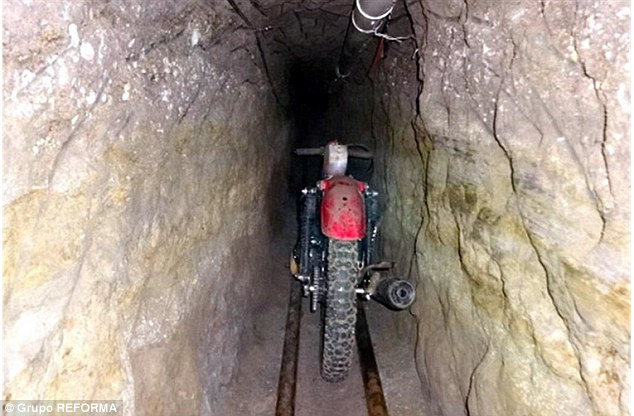El Chapo's ride to freedom
Astonishing pictures of the mile-long tunnel through which Sinaloa Cartel boss El Chapo made his escape from a maximum-security prison have emerged today. The photographs show the tunnel's motorbike on wheels, ventilation pipes and a ladder in the shaft connecting the tunnel to the jail.
The motorbike, which was secured at its front wheel to the rails, was waiting for El Chapo as he descended into the tunnel from the prison shower block on Saturday night.
It is believed he spent $50million on the elaborate underground escape route, which took his engineers around a year to complete.
The slim tunnel, complete with oxygen-supply piping overhead, was bored by the Sinaloa Cartel’s expert mining engineers, using professional equipment. They would have had to remove more than 3,250 tonnes of earth.
Cartel leader El Chapo, who got his nickname ('The Shorty') from his 5ft 6ins stature, would have been able to stand up in the tunnel.
He prised open a grill in the prison showers, unnoticed by guards, before climbing down a 32ft shaft into the tunnel.
In a video interview, Pablo Escobar’s former chief henchman estimated that El Chapo’s escape would have cost in the region of $50million.
Speaking to news channel Univision, Escobar’s top gunman known as ‘Popeye’, said that tunnelling out of maximum security prison is very difficult without the complicity of at least some of the guards, who are equipped with highly sensitive sonar equipment that will pick up any mining activity.
‘You have to buy off the guards if you want to have a chance’, said the cartel killer. ‘And they know how rich he is, they’ll have asked for tens of millions of dollars’.
‘El Chapo probably paid around 50 million in bribes alone’.
More than 30 employees who worked at the prison have already been pulled in for questioning in the course of the interview.
Three prison system officials have been fired, including the prison director.
And in a previous prison escape El Chapo had bribed prison guards to push him out of the Puente Grande maximum-security prison, in the western state of Jalisco, in a laundry cart.
The Colombian said that while El Chapo may have escaped for the moment from the Mexican authorities, he won’t last long with the CIA and DEA on his tail.
‘Sooner or later he’ll be caught’, he said, ‘it’s not a matter of if, rather than when’.
It came as Mexico’s judiciary and politicians came under scrutiny for their refusal to accede to US demands to extradite him, where he would have been kept in a supermax prison.
In the US he faced 35 charges including of cocaine and marijuana trafficking, organised crime and money laundering.
He faces charges from a number of federal tribunals, including in Illinois, New York, Florida, Texas, California and Arizona, given that the United States in the largest marketplace of the Sinaloa cartel.
Mexican newspaper La Reforma reported that the US Attorney’s department had filed six separate extradition orders for El Chapo to the Mexican government.
Following his arrest in February of last year the US immediately petitioned the Mexican government for his extradition.
The U.S. made a series of requests to extradite El Chapo to face criminal charges in the United States.
Instead of ceding to the Americans’ wishes the Mexican president, who had been elected the year before on promises to bring down the country’s top cartel.
It’s the second time that El Chapo has escaped the clutches of the US justice system. His extradition was also imminent in 2001 when he escaped from the Puente Grande maximum security prison in the west of Mexico, hidden inside a laundry basket.
The most recent formal request for his extradition came from the Obama administration in January, delivered to Mexico’s Ministry of the Exterior by the US Embassy in Mexico City.
Despite 60% of Mexicans being in favour of his removal to the United States on the grounds that they feared he would escape again, according to polls taken shortly after his capture in 2014, Mexico’s Attorney General at the time, Jesus Murillo Karam, assured the country that the risk of his escape a second time ‘did not exist’.
The Attorney General said that Mexico holding onto to Guzman was an issue of ‘National Sovereignty’, and joked that the US could have him once he had served his his Mexican sentence of ‘about 300 to 400 years’.
Under the previous Mexican administration of President Calderón a large amount of Mexican criminals were extradited to the United States, none of whom have since escaped from federal prison.
Read the original story on the Daily Mail

